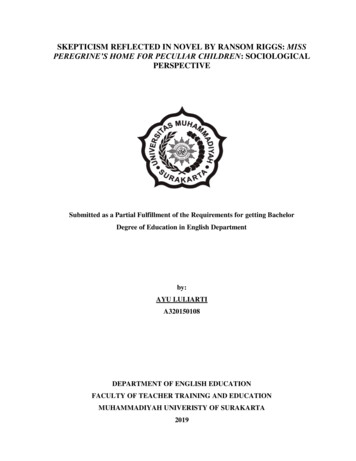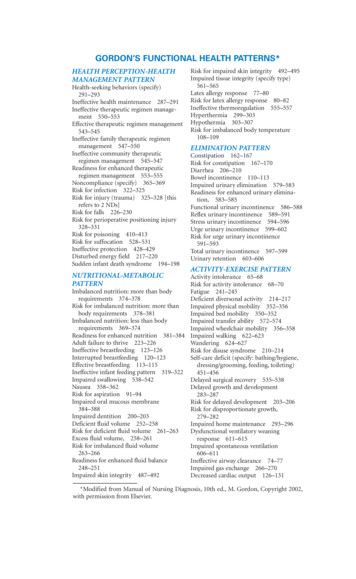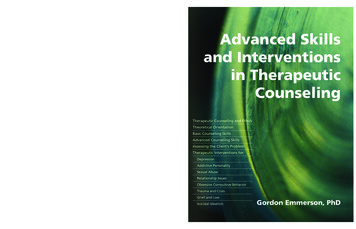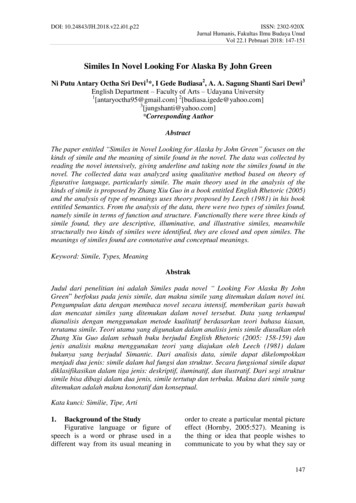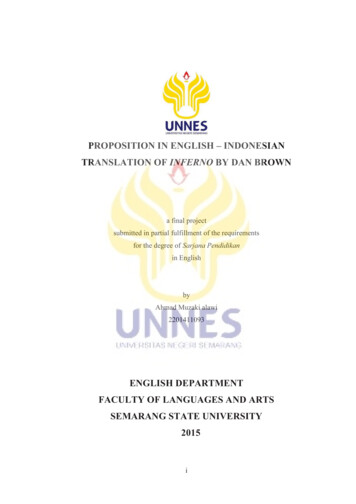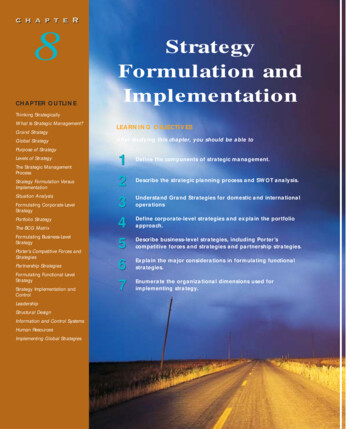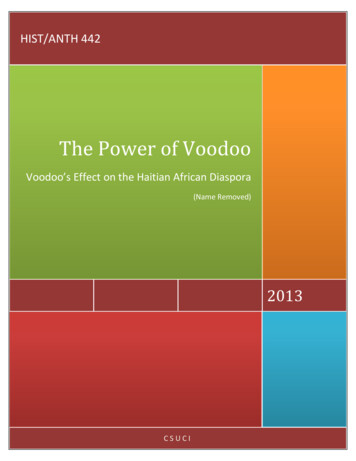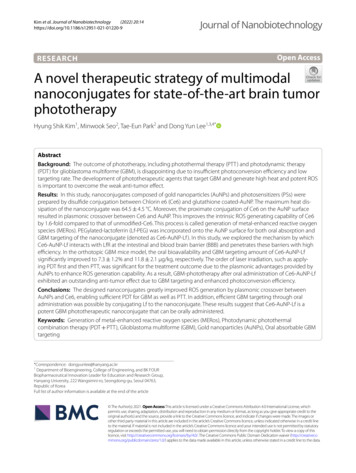
Transcription
(2022) 20:14Kim et al. Journal of 1-01220-9Journal of NanobiotechnologyOpen AccessRESEARCHA novel therapeutic strategy of multimodalnanoconjugates for state‑of‑the‑art brain tumorphototherapyHyung Shik Kim1, Minwook Seo2, Tae‑Eun Park2 and Dong Yun Lee1,3,4*AbstractBackground: The outcome of phototherapy, including photothermal therapy (PTT) and photodynamic therapy(PDT) for glioblastoma multiforme (GBM), is disappointing due to insufficient photoconversion efficiency and lowtargeting rate. The development of phototherapeutic agents that target GBM and generate high heat and potent ROSis important to overcome the weak anti-tumor effect.Results: In this study, nanoconjugates composed of gold nanoparticles (AuNPs) and photosensitizers (PSs) wereprepared by disulfide conjugation between Chlorin e6 (Ce6) and glutathione coated-AuNP. The maximum heat dis‑sipation of the nanoconjugate was 64.5 4.5 C. Moreover, the proximate conjugation of Ce6 on the AuNP surfaceresulted in plasmonic crossover between Ce6 and AuNP. This improves the intrinsic ROS generating capability of Ce6by 1.6-fold compared to that of unmodified-Ce6. This process is called generation of metal-enhanced reactive oxygenspecies (MERos). PEGylated-lactoferrin (Lf-PEG) was incorporated onto the AuNP surface for both oral absorption andGBM targeting of the nanoconjugate (denoted as Ce6-AuNP-Lf ). In this study, we explored the mechanism by whichCe6-AuNP-Lf interacts with LfR at the intestinal and blood brain barrier (BBB) and penetrates these barriers with highefficiency. In the orthotopic GBM mice model, the oral bioavailability and GBM targeting amount of Ce6-AuNP-Lfsignificantly improved to 7.3 1.2% and 11.8 2.1 μg/kg, respectively. The order of laser irradiation, such as apply‑ing PDT first and then PTT, was significant for the treatment outcome due to the plasmonic advantages provided byAuNPs to enhance ROS generation capability. As a result, GBM-phototherapy after oral administration of Ce6-AuNP-Lfexhibited an outstanding anti-tumor effect due to GBM targeting and enhanced photoconversion efficiency.Conclusions: The designed nanoconjugates greatly improved ROS generation by plasmonic crossover betweenAuNPs and Ce6, enabling sufficient PDT for GBM as well as PTT. In addition, efficient GBM targeting through oraladministration was possible by conjugating Lf to the nanoconjugate. These results suggest that Ce6-AuNP-Lf is apotent GBM phototherapeutic nanoconjugate that can be orally administered.Keywords: Generation of metal-enhanced reactive oxygen species (MERos), Photodynamic photothermalcombination therapy (PDT PTT), Glioblastoma multiforme (GBM), Gold nanoparticles (AuNPs), Oral absorbable GBMtargeting*Correspondence: dongyunlee@hanyang.ac.kr1Department of Bioengineering, College of Engineering, and BK FOURBiopharmaceutical Innovation Leader for Education and Research Group,Hanyang University, 222 Wangsimni‑ro, Seongdong‑gu, Seoul 04763,Republic of KoreaFull list of author information is available at the end of the article The Author(s) 2021. Open Access This article is licensed under a Creative Commons Attribution 4.0 International License, whichpermits use, sharing, adaptation, distribution and reproduction in any medium or format, as long as you give appropriate credit to theoriginal author(s) and the source, provide a link to the Creative Commons licence, and indicate if changes were made. The images orother third party material in this article are included in the article’s Creative Commons licence, unless indicated otherwise in a credit lineto the material. If material is not included in the article’s Creative Commons licence and your intended use is not permitted by statutoryregulation or exceeds the permitted use, you will need to obtain permission directly from the copyright holder. To view a copy of thislicence, visit http:// creat iveco mmons. org/ licen ses/ by/4. 0/. The Creative Commons Public Domain Dedication waiver (http:// creat iveco mmons. org/ publi cdoma in/ zero/1. 0/) applies to the data made available in this article, unless otherwise stated in a credit line to the data.
Kim et al. Journal of Nanobiotechnology(2022) 20:14Page 2 of 27Graphical AbstractBackgroundGlioblastoma multiforme (GBM) is the primary grade IVbrain malignancy and carries a fatal prognosis. The current standard treatment for GBM involves multimodaltherapies including surgical resection, chemotherapy, andradiotherapy. Despite these treatments, the survival ratefor patients with GBM is less than 1 year [1, 2]. From aclinical point of view, effective treatment of GBM is limited by several challenges. First, the anatomical complexity and size of the tumor influence the extent of resection.This is because a balance must be achieved between maximum removal of malignant tissue and minimum surgical risk [3]. Even with safe operative resection, residualinfiltrating GBM cells that cannot be detected by imagingtechniques can remain in the tumor periphery, leadingto disease progression and death [4]. Secondly, GBM ischaracterized by high heterogeneity between intra-tumorand inter-tumor regions at cellular and histological level.This peculiarity of GBM containing tissues induces different responses to therapeutic agents, leading to failure of targeted therapy [5, 6]. Lastly, the central nervoussystem (CNS) has a distinct microenvironment that isprotected by the blood brain barrier (BBB), restrictingsystemically delivered drugs from accessing the brain.This reduces the treatment options available for GBM.Therefore, development of more sophisticated and powerful treatments is one of the most pressing challenges.Photothermal therapy (PTT) is based on local application of high temperatures to tissues to induce irreversible cellular damage at the target site and is considereda promising strategy for cancer treatments [7]. It is anon-invasive treatment that involves local irradiation ofthe tumor using an external near-infrared (NIR) laser.Upon laser irradiation, the photothermal agent harvestslight energy, converts it, and releases it as heat [8, 9]. Thesubsequent temperature increase causes protein denaturation, cellular membrane disruption, enzyme dysfunction, and mitochondrial corruption, leading to tumorcell death and coagulative necrosis [10]. The advantageof PTT as a cancer treatment is that cancerous tissue ismore sensitive to heat than is normal tissue, allowingmaximum anti-tumor effects while limiting damage tosurrounding healthy tissue. This tumor is probably due tothe acidic interstitial environment, reduced heat dissipation capacity, and increased metabolic stress [11]. PTT isregarding as a paradigm shifting strategy for non-chemical treatment of GBM using heat to destroy tumors. Themethod possesses a number of advantages that circumvent the limitations of GBM heterogeneity, drug resistance mechanisms, and adverse effects on surroundinghealthy tissues [7]. However, there are challenges todeveloping nanoparticles that enable effective PTT onGBM. Upon systemic administration, these nanoparticles must overcome the BBB and reach the GBM site attherapeutic concentrations, and the NIR irradiation mustcross multiple barriers (skull, scalp, and normal brain tissue) to reach the tumor site without adverse effects.Photodynamic therapy (PDT) also involves application of light at an appropriate wavelength to activate aphotosensitizer (PS). Upon light irradiation, PS initiates relaxation of its electronically excited state throughintersystem crossing that leads to production of reactiveoxygen species (ROS) [12, 13]. Generation of ROS byactivated PS induces a series of physiological responsesresulting in cell death. Therefore, PDT is considered apromising cancer therapeutic technique due to its minimally invasive and spatiotemporal properties [12, 14].Nevertheless, PDT for cancer therapy suffers insufficient
Kim et al. Journal of Nanobiotechnology(2022) 20:14tumor accumulation and limited transmittance of external irradiation light, resulting in deficient ROS production. Chlorin e6 (Ce6) is the most widely used porphyrinanalog PS in PDT and is a second generation PS withhigh potency and low dark toxicity [15, 16]. However,application of Ce6 to tumor treatment is limited due toits low water solubility, which prevents its accumulationin tumors at therapeutic levels and cannot lead to sufficient PDT results. The use of 5—40 nm sized AuNPs asCe6 delivery carriers can address the low water solubility and increase tumor accumulation [17]. Moreover, thesurface plasmon resonance (SPR) effect of AuNPs bothallows them to be utilized as a PTT agent [18] and amplifies the Raman signal of Ce6 immobilized close to thesurface [19–21]. Therefore, a synergistic effect of phototherapy can be anticipated through plasmonic amplification from AuNPs to Ce6, which is directly related tophotoconversion efficiency [22].Metal enhanced fluorescence (MEF) is a phenomenon in which strong surface plasmons of the metalenhances the fluorescence and Raman signals of molecules adsorbed close to the metal surface (Fig. 1a) [23].In a study examining AuNP carrying PSs [24, 25], fluorescence of conjugated Ce6 on the AuNPs surface wasenhanced threefold, and ROS production was increased1.4-fold. Therefore, synergistically increasing MEF andmetal enhanced ROS generation (MERos) can be maximized through conjugation between AuNPs and Ce6(Fig. 1b). Consequently, this strategy can be used as atumor treatment that simultaneously applies high-efficiency PDT and PTT [26].Oral administration is the preferred mode of drugdelivery, primarily due to its simplicity and patient convenience. In this regard, lactoferrin (Lf ) is generallydelivered orally and is absorbed by interactions withthe lactoferrin receptor (LfR) expressed in intestinalendothelial cells, BBB, and GBM. Therefore, Lf was conjugated to the AuNPs surface to improve the low oral bioavailability and GBM targeting of AuNPs as described inour previous study [27].Herein, we developed Ce6-AuNP-Lf that conjugatedglutathione-coated AuNP (GSH-AuNP) with the photosensitizer Ce6 and with Lf via a polyethylene glycol(PEG) linker. By proximately conjugating AuNP andCe6, potent PDT and PTT were available by MERosin GBM. Furthermore, in the GI tract and BBB, bothPage 3 of 27passive and receptor-mediated transport of Ce6-AuNPLf was achieved by nano-size and LfR-mediated transcytosis, respectively. The highly efficient targeting ofCe6-AuNP-Lf to GBM by oral administration resultedin a concentration of 11.8 2.1 μg/kg. Afterward, GBMwas effectively eradicated with dual treatments includingPTT and PDT, which were improved by MERos of Ce6AuNP-Lf (Fig. 1c).Results and discussionPreparation and characterization of Ce6‑AuNP‑LfnanoconjugatePDT and PTT combination therapeutic AuNPs weredeveloped by disulfide conjugation between thioureamodified Ce6 and the thiol-abundant glutathione coatedAuNP surface. PEGylated-Lf with a thiol-functionalizedPEG (Lf-PEG) was incorporated into the AuNP surfaceby disulfide bonds (Ce6-AuNP-Lf ) (Fig. 1d). The FT-IRspectra verified thiourea binding to Ce6 through amideformation (Additional file 1: Figure S1). The first solution was Ce6 modified with thiourea (Ce6-thiol) and thesecond solution was unmodified Ce6 simply mixed withthiourea (Ce6 thiourea). The most significant changesin the spectra in the range between 1550 and 1750 cm 1was a band at 1708 cm 1, which corresponds to the C Ostretching of carboxylic acids in Ce6 [28]. Ce6-thiolshowed a band at 1642 cm 1 in the vibrational mode ofthe amide 1 bond. The new radical formed at 1642 cm 1and the decrease intensity at 1708 cm 1 indicate modification of carboxylic acids radicals during amide formation [29]. Next, we tried to prove that Ce6-thiol andPEGylated-Lf were bound to the AuNP surface via Au–Sbond through FT-IR spectra. However, it was difficultto identify the newly formed disulfide through adsorption on the AuNP surface because these bands shoulddisappear due to diffusion of the molecules. Instead,to confirm the bond, we detected the specific peak ofCe6 and AuNP. The UV–vis spectrum of the synthesized Ce6-AuNP exhibited specific peaks of Ce6 andAuNP at 400-nm/532-nm and at 671-nm wavelengths,respectively (Fig. 2a). This result demonstrate that it waschemically bound between Ce6-thiol and AuNP by thedisulfide bond as intended. Moreover, the binding ratiobetween Ce6 and AuNP in the Ce6-AuNP was calculatedusing the absorbance measured at each wavelength andthe molar extinction coefficients of AuNP and Ce6. The(See figure on next page.)Fig. 1 Synthesis of Ce6-AuNP-Lf capable of strong PDT by MERos and the mechanism of GBM treatment. a Schematic illustration of AuNP localizedsurface plasmon resonance (LSPR). b Mechanism of metal-enhanced fluorescence (MEF) and metal-enhanced reactive oxygen generation (MERos)by plasmon coupling between AuNP and the conjugated-photosensitizer (PS). c Oral absorption and GBM targeting through LfR-mediatedpathways of the GI tract, BBB barrier, and GBM cells. Thereafter, the accumulated Ce6-AuNP-Lf in GBM induces apoptosis and necrosis through PTTand PDT, respectively. d Synthetic procedure of Ce6-AuNP-Lf by thiolation of Chlorin e6 (Ce6) and PEGylation of Lactoferrin (Lf ). The illustration wascreated with BioRender.com
Kim et al. Journal of NanobiotechnologyFig. 1 (See legend on previous page.)(2022) 20:14Page 4 of 27
Kim et al. Journal of Nanobiotechnology(2022) 20:14results showed that an average of 4.5 Ce6 were bound toone AuNP. In addition, our previous study showed thatapproximately 19.7 GSH-AuNP were bound to one LfPEG to make Lf-PEG-AuNP conjugates, which was confirmed by using BCA assay, SDA-PAGE (sodium dodecylsulfate polyacrylamide gel electrophoresis), and UV–Visspectra [27].The surface charge of Ce6, Ce6-AuNP and Ce6-AuNPLf were 9.4 4.3, 32.7 10.3 and, 26.8 5.2,respectively (Fig. 2b). From the TEM images, each particle size of Ce6-AuNP and Ce6-AuNP-Lf measured byTEM was about 5 nm (Fig. 2c, see yellow square box).Interestingly, Ce6-AuNP-Lf was well dispersed, whileCe6-AuNP was highly aggregated as shown Fig. 2c.In fact, the aggregated diameters of Ce6-AuNP were945.2 142.4, 182.1 40.8 and 9.49 12.8 nm, whichwere within the proportions of 46.4%, 40.8% and 12.8%,respectively (Fig. 2d). The cations present in the solution bound to the carboxylic acid of glutathione coatedon the AuNP surface and neutralized the surface charge.This induced irreversible aggregation of AuNP into largestructures [30]. However, the aggregated diametersof Ce6-AuNP-Lf were within 7.8 2.6, 15.9 6.2 and81.1 15.4 nm in proportions of 64.8%, 20.2% and 15.1%,respectively (Fig. 2d). The steric stabilization mediated byPEGylation of Ce6-AuNP-Lf prevented particle aggregation. Maintaining Ce6-AuNP-Lf in sizes from 5 to 20 nmis key for efficient PTT because the surface plasmon resonance (SPR) of AuNP irradiated with PTT laser (532 nmwavelength) is highly reliant on NP size [31]. To evaluate the PTT efficiency of Ce6-AuNP-Lf, 4 W/cm2 intensity of PTT laser (532 nm wavelength) was irradiated tothem. From the previous literature, it was reported thatcancer cell destruction linearly increased in the nearinfrared laser intensity range of 1.5–4.7 W/cm2 [32]. Themaximum temperature ( Tmax) of Ce6-AuNP-Lf irradiated with 4 W/cm2 intensity of PTT laser for 240 minwas 64.5 4.5 C (Fig. 2e and Additional file 2: Movie S1),while Tmax of Ce6-AuNP was 43.0 3.7 C (Fig. 2e andAdditional file 3: Movie S2). Likewise, AuNP, which isvulnerable to aggregation between particles, also showedpoor heat generation as in Ce6-AuNP. From these results,the photothermal stability of each nanoparticle was calculated as summarized in Table 1. Ce6-AuNP-Lf showedthe highest PTT efficiency despite surface modificationof AuNP with Lf protein and Ce6 photosensitizer. Also,PEGylated Lf-conjugated AuNP (AuNP-Lf ) also showedPage 5 of 27higher PTT efficiency, suggesting that Lf protein conjugation did not affect the PTT efficiency of AuNP itself.Collectively, we found that steric stabilization by PEGylation of AuNP has a profound effect on PTT efficiency.The hydrophobicity of Ce6, Ce6-AuNP and Ce6-AuNPLf was assessed through phase transfer between octanoland DW. Here, Ce6-AuNP and Ce6-AuNP-Lf exhibitedhydrophilicity despite conjugation with hydrophobicCe6 (Additional file 1: Figure S2). The AuNP conjugationconferred hydrophilicity that could potentially facilitatemuco-penetration in mucus barriers, where the mucinprotein constructs hydrophobic bonds with NPs duringoral absorption [33]. Furthermore, the surface hydrophobicity of NPs promotes immune recognition bymacrophages, allowing the hydrophilic Ce6-AuNP-Lf toreduce undesirable immunostimulation [34]. Therefore,Ce6-AuNP-Lf is expected to be a promising Ce6 deliverycarrier to enhance the accumulation of hydrophobic Ce6in GBM through oral absorption.Metal‑enhanced reactive oxygen generation (MERos)by conjugation of Ce6 to the AuNP surfaceDuring 10 min of PDT laser irradiation, the Ce6 fluorescence of free-Ce6, Ce6-AuNP and Ce6-AuNP-Lfgradually decreased to 57.0 5.6%, 17.1 2.5% and13 2.6%, respectively (Fig. 3a). Due to photobleaching, fluorescence decreased with light irradiation by afourfold larger change in Ce6-AuNP and Ce6-AuNPLf compared to free-Ce6. This is due to MEF by plasmon coupling between AuNP and Ce6, which improvesfluorescence intensity but triggers photobleaching [35].This process is explained by the MEF rather than theFRET of the distance-dependent energy transfer process between the two fluorophores. Since AuNPs donot act as fluorophores, unlike Ce6, metal nanoparticles such as Au, Ag, Cu, and Pt are more suitable asMEFs that increase the fluorescence intensity of fluorophores [36]. In addition, from the UV–vis spectrogram, AuNP-conjugated Ce6 (Ce6-AuNP) showed a1.3-fold improved excitation compared to free Ce6 inthe fluorescence excitation spectrum (Fig. 3b). Thisdemonstrated the role of AuNP as a nanoantennathat increased the excitation energy of Ce6, whichcan either induce fluorescence or generate ROS [37].In fact, the decrease of Ce6 fluorescence via photoexcitation is related to ROS generation [38]. This isbecause the generated ROS depletes the remaining Ce6,(See figure on next page.)Fig. 2 Characterization of Ce6-AuNP-Lf. a UV–vis absorbance spectra of AuNP, Ce6, Ce6-AuNP and Ce6-AuNP-Lf having specific peaks at 400, 532and 671 nm wavelengths. b Surface charge of Ce6, Ce6-AuNP and Ce6-AuNP-Lf. Data were expressed as mean SEM (n 3). c TEM images andenergy-dispersive X-ray spectroscopy (EDX) result of Ce6-AuNP and Ce6-AuNP-Lf. Magnified image: yellow square box in original image. Scalebar: 50 nm. d Proportion of hydrodynamic size in Ce6-AuNP and Ce6-AuNP-Lf. e Temperature changes of Ce6-AuNP and Ce6-AuNP-Lf under theexposure with 4 W/cm2 intensity of PTT (532 nm) laser
Kim et al. Journal of NanobiotechnologyFig. 2 (See legend on previous page.)(2022) 20:14Page 6 of 27
Kim et al. Journal of Nanobiotechnology(2022) 20:14Page 7 of 27Table 1 The photothermal stability of AuNP, AuNP-Lf, Ce6-AuNP, and Ce6-AuNP-LfLaser (wavelength, power)Irradiation time (sec)Maximum temperature(Tmax)PTT efficacy (Tmax–T0)AuNP532 nm, 4 W/cm2240 sAuNP-Lf532 nm, 4 W/cm2240 s45.4 4.2 C20.3 2.1 CCe6-AuNP532 nm, 4 W/cm2240 sCe6-AuNP-Lf532 nm, 4 W/cm2240 s43.0 3.7 C18.4 1.7 C56.3 0.5 C64.5 4.5 C29.6 0.2 C39.3 1.3 CThe temperature changes caused by laser irradiation of AuNP, AuNP-Lf, Ce6-AuNP and Ce6-AuNP-Lf PTT, respectively, measured with a thermal imaging cameraTmax, Maximum temperature; T0, Initial temperaturereducing fluorescence [39]. Consistent with the correlation between ROS generation and fluorescence reduction, in our results, PDT irradiation generated 1.6-foldmore ROS in the AuNP-conjugated Ce6 (Ce6-AuNPand Ce6-AuNP-Lf ) than with free-Ce6 (Fig. 3c). Therefore, MEF and ROS production in AuNP-conjugatedCe6 such as Ce6-AuNP and Ce6-AuNP-Lf is characterized by simultaneous increase (Fig. 3d). There areseveral papers demonstrating the correlation betweenMEF and ROS production between AuNP and PSs. [24,40] The mechanisms of the relationship between MEFand MERos are expected to be due to inter-systemcrossover between AuNP and PSs, which promotes thetriplet state of PSs [41]. In this regard, the proximity ofCe6 to the gold ions on the AuNP surfaces enhancedspin–orbit coupling due to the external heavy atomeffect [42, 43], increasing triplet formation.Moreover, Ce6-AuNP and Ce6-AuNP-Lf had significant differences in ROS generation ability according tothe application sequence of PDT and PTT (Fig. 3e). Asa result, ROS generation was lowest in the PTT PDT(applying PTT then PDT). However, it was rather effective in single PDT and PDT PTT (applying PDT thenPTT). This can be explained as follows. In the case ofPTT PDT (applying PTT then PDT), (1) AuNPs generate high heat in response to the first applied PTT laser.(2) Then, Ce6 probably separates from the AuNP surfaceor destroys the porphyrin structure of Ce6. (3) MERosno longer exist due to loss of plasmon coupling betweenCe6 and AuNP. (4) Therefore, ROS generation of thePTT PDT laser group was relatively lower than that ofsingle PDT or the PDT PTT laser group (Fig. 3f ).Stability of Ce6‑AuNP in an oral absorption‑ mimickingenvironmentTo evaluate the colloidal stability of Ce6-AuNP-Lf during the oral absorption procedure, we first mimicked thepH environments of the gastric and intestinal system.At pH 2, the absorbance of Ce6-AuNP-Lf was slightlydecreased at 532 and 671 nm, but there was no peak shift(Additional file 1: Figure S3a). At pH 5, no peak shift ordecrease in absorbance were observed until 24 h (Additional file 1: Figure S3b). To more specifically simulate the oral absorption procedure of Ce6-AuNP-Lf, itwas serially exposed to pH 2 for 3 h and then pH 5 foran additional 12 h (Additional file 1: Figure S3c) [44].Ce6-AuNP-Lf showed stability without peak shift anddecreased absorbance in both the 532 and 671 nm wavelength bands. As a result, Ce6-AuNP-Lf maintained thecolloidal stability of AuNP and undesired release of Ce6was not detected at the pH conditions of the GI tract.Furthermore, Ce6-AuNP-Lf was stable in both physiological solution of PBS and of 10% FBS for 180 days (Additional file 1: Figure S4a and 4b). Based on these findings,we conclude the suitability of Ce6-AuNP-Lf as an oralformulation.Enhanced permeability of Ce6‑AuNP‑Lf at the epithelialbarriers of the GI tractIn oral absorption of drugs, the administered AuNP,Ce6-AuNP and Ce6-AuNP-Lf penetrate through thesmall intestine into the blood. Therefore, the toxicitiesof AuNP, Ce6-AuNP and Ce6-AuNP-Lf were examinedusing Caco-2 cells and human umbilical vein endothelial cells (HUVECs). Treatment with NPs did not cause(See figure on next page.)Fig. 3 Enhancement of ROS generation ability of AuNP-conjugated Ce6, mediated by MERos. a Photobleaching of Ce6 by PDT irradiation infree-Ce6, Ce6-AuNP, and Ce6-AuNP-Lf groups. Data are expressed as mean SEM (n 3). b Fluorescence excitation spectra of free-Ce6 andCe6-AuNP with 2.5 μM Ce6 equivalent concentration. c SOSG assay to detect ROS generation by 5 min PDT laser irradiation. Data are expressedas mean SEM (n 3). ***P 0.001. d Schematic illustration of improved fluorescence and ROS generation of Ce6 by plasmon coupling betweenAuNP and Ce6. e Alteration of ability to generate ROS according to laser sequence. The single PDT group was irradiated for 5 min and combinedlaser groups (PTT PDT laser order or PDT PTT laser order) were irradiated for 2.5 min each. Data are expressed as mean SEM (n 3). *P 0.05,**P 0.01, ***P 0.001. f Schematic illustration of the lost MERos effect by first applying the PTT laser in the PTT PDT laser order
Kim et al. Journal of NanobiotechnologyFig. 3 (See legend on previous page.)(2022) 20:14Page 8 of 27
Kim et al. Journal of Nanobiotechnology(2022) 20:14significant cytotoxicity and morphological changes inCaco-2 cells and HUVECs (Fig. 4a–c). Intestinal epithelial cells, including Caco-2 cells, express LfR on theirmembranes [45–47]. Thus, the Caco-2 cell permeability test was conducted to determine whether the permeation of Ce6-AuNP-Lf was increased by LfR in the GItract. Furthermore, the TEER values decreased with drugtransmittance in the Caco-2 cell monolayer. As a result,the TEER values of the Ce6, Ce6-AuNP and Ce6-AuNPLf groups decreased to 52.4%, 62.7%, and 48.9% respectively (Fig. 4d).In general, two routes (transcellular and paracellularpathways) are available for transport through the Caco-2cell barrier. The transcellular route of barrier is employedby lipophilic drugs and by molecules selectively transported by receptors, channels, pumps and carriers present in the plasma membrane. Therefore, transmittanceof hydrophobic Ce6 ( 47.6%) can be interpreted as theresult of transcellular diffusion into the cellular plasmamembrane. However, the hydrophilic Ce6-AuNP andCe6-AuNP-Lf also were transported through the barrier in amounts of 37.3% and 51.1% respectively. In fact,AuNP treatment is known to increase the paracellularpathway in the in vitro epithelial and endothelial permeability assay. This is known to be mediated by suppressionof threonine phosphorylation on occludin and zonulaoccludens-1 (ZO-1), and of perturbed occludin/ZO-1complex formation and disassembly of tight junctions[48, 49]. Therefore, Ce6-AuNP and Ce6-AuNP-Lf wereable to cross the Caco-2 cell barrier through the paracellular pathway at the tight junctions. Furthermore, wespeculated that the enhanced permeability of Ce6-AuNPLf ( 13% permeability) compared to Ce6-AuNP wasdue to the LfR-mediated transcytosis in the Caco-2 cellbarrier. In general, pinocytosis is known to uptake smallAuNPs ( 500 nm) by forming protrusions on the cellsurface, but the corresponding process was not verifiedin the Bio TEM results after treatment with Ce6-AuNP[50]. In contrast, intracellular entrapment of Ce6-AuNPLf in vesicles was observed, which explains LfR-mediatedtranscytosis in Caco-2 cells (Fig. 4e).The pretreated-Lf/Ce6-AuNP-Lf group was used toverify only the passive transport of Ce6-AuNP-Lf byexcluding the LfR-mediated transport. The LfRs on theCaco-2 cell monolayer were fully occupied with free LfPage 9 of 27in advance and then Ce6-AuNP-Lf was further treated(Additional file 1: Figure S5). The difference in transmittance between the Pretreated-Lf / Ce6-AuNP-Lf groupand Ce6-AuNP-Lf group was 24.8%. This demonstratesthat 24.8% of Ce6-AuNP-Lf are transported through LfRmediated transcytosis and the remaining 26.3% are passively transported through a LfR-independent route, aswith Ce6-AuNPs (Fig. 4d).Ce6‑AuNP‑Lf permeates the BBB by LfR‑mediatedtranscytosis and accumulate in GBM cells, resultingin severe phototoxicity by the MERos effectThe permeability of Ce6-AuNP-Lf in BBB was examined using a human BBB Transwell model [51]. The BBBmodel was prepared by culturing human brain microvascular endothelial cells on the apical side of the insertinterfaced with primary human pericytes and astrocytes(Fig. 5a). TEER value, an indicator of development oftight junction, was measured to determine the barrier function of BBB. The BBB endothelium showed aphysiological level of TEER value (average 4079 Ω·cm2),indicating that the BBB model can provide very limitedparacellular transport. The expression of transport systems including functional efflux pump and receptorssuch as LfR and transferrin receptor (TfR) was previouslydemonstrated [51].We measured the amount of AuNPs that crossed theBBB using the human BBB Transwell model. To monitorthe amount of AuNPs across the BBB during the assay,apparent permeability (Papp) of FITC-Dextran (3 kDa)was measured to evaluate the integrity of tight junctions (Fig. 5b). The concentration of Ce6-AuNP-Lf in thebasal chamber of Transwell was 8.13 times higher thanthe concentration of Ce6-AuNP indicating that functionalization with Lf significantly enhanced BBB penetration efficacy without breakdown of barrier function(Fig. 5c). Bio TEM images showed that Ce6-AuNP-Lf wasinternalized by brain endothelial cells packed by vesiclesimplying the LfR-mediated endocytosis of Ce6-AuNP-Lf(Fig. 5d). A competitive assay was conducted to assessqualitative binding information of Ce6-AuNP-Lf to theLfR expressed on BBB which can lead to transcytosis ofNPs. Pretreatment with Lf to a BBB model decreasedBBB penetration of Ce6-AuNP-Lf by 52%, which demonstrates that BBB penetration of Ce6-AuNP-Lf is(See figure on next page.)Fig. 4 In vitro small intestine epithelial (Caco-2) cytotoxicity and permeability study of Ce6-AuNP-Lf. a Morphology of small intestinal Caco-2 cellsand human umbilical vein endothelial cells (HUVECs) after treatment with AuNP, Ce6-AuNP and Ce6-AuNP-Lf for 24 h. Magnification: 100. Scalebar: 100 μm. b The viability of Caco-2 cells after treatment with AuNP, Ce6-AuNP, and Ce6-AuNP-Lf, respectively, for 24 h. Data are expressed asmean SEM (n 8). c The viability of HUVECs after treatment of AuNP, Ce6-AuNP and Ce6-AuNP-Lf, respectively, for 24 h. Data are expressed asmean SEM (n 8). d TEER value through Caco-2 cell monolayer after treatment of each group. Data are expressed as means SEM (n 4). e TEMimages of Caco-2 cell monolayers treated with Ce6-AuNP and Ce6-AuNP-Lf. Yellow arrows: Ce6-AuNP. Orange arrows: Ce6-AuNP-Lf internalizedthrough LfR endocytosis. Scale bar: 500 nm
Kim et al. Journal of NanobiotechnologyFig. 4 (See legend on previous page.)(2022) 20:14Page 10 of 27
Kim et al. Journal of Nanobiotechnology(2022) 20:14dependent on the interaction between Lf and LfR (Fig. 5cand Additional file 1: Figure S5). The Bio-TEM imagesof Ce6-AuNP-Lf also revealed that Ce6-AuNP-Lf is notinternalized by brain endothelial cells in
nanoconjugates for state-of-the-art brain tumor phototherapy Hyung Shik Kim1, Minwook Seo2, Tae‑Eun Park 2 and Dong Yun Lee1,3,4* Abstract Background: The outcome of phototherapy, including photothermal therapy (PTT) and photodynamic therapy (PDT) for glioblastoma multiforme (GBM), is disap
